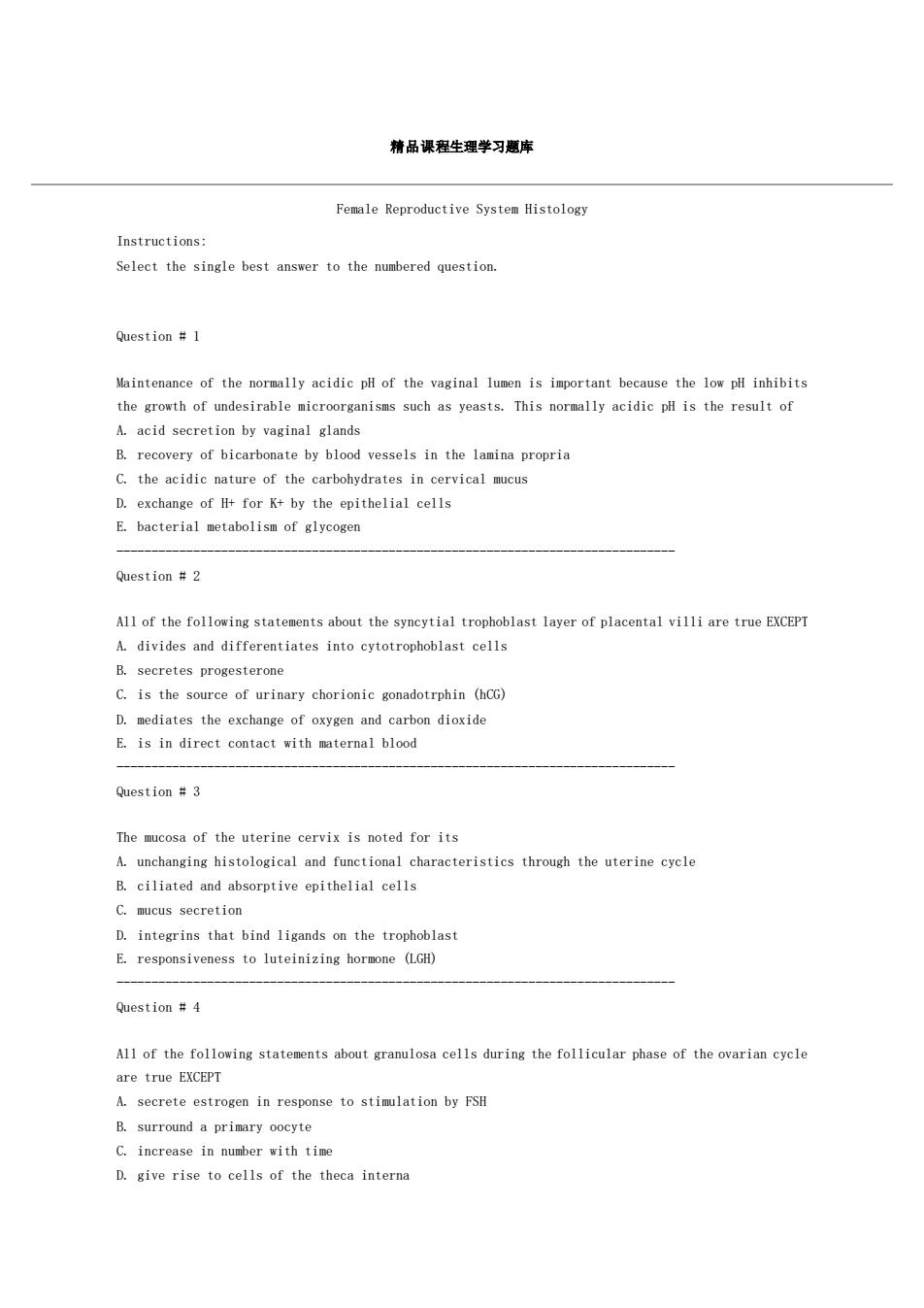
精品课程生理学习题库 Female Reproductive System Histology Instructions: Select the single best answer to the numbered question. Question1 Maintenance of the orally acidic pl of the vaginal lun is important because the low l inhibits the growth of undesirable microorganisms such as yeasts.This normally acidic is the result of A.acid secretion by vaginal glands B.recovery of bicarbonate by blood vessels in the lamina propria C.the acidic nature of the carbohydrates in cervical mucus D.exchange of #for K+by the epithelial cells E bacterial metabolism of glycogen Question #2 All of the following statements about the syncytial trophoblast layer of placental villi are true EXCEPT A.divides and differentiates into cytotrophoblast cells C.is the source of urinary chorionic gonadotrphin (hG) D.mediates the exchange of oxygen and carbon dioxide E.is in direct contact with maternal blood Question#3 The mucosa of the uterine cervix is noted for its A.unchanging histological and functional characteristics through the uterine cycle B.ciliated and absorptive epithelial cells C.mucus secretion D.integrins that bind ligands on the trophoblast E responsiveness to luteinizing hormone (LGH) Question4 All of the following statements about granulosa cells during the follicular phase of the ovarian cycle are true EXCEPT A.secrete estrogen in response to stimulation by FSH B.surround a pria D.give rise to cells of the theca interna
精品课程生理学习题库 Female Reproductive System Histology Instructions: Select the single best answer to the numbered question. Question # 1 Maintenance of the normally acidic pH of the vaginal lumen is important because the low pH inhibits the growth of undesirable microorganisms such as yeasts. This normally acidic pH is the result of A. acid secretion by vaginal glands B. recovery of bicarbonate by blood vessels in the lamina propria C. the acidic nature of the carbohydrates in cervical mucus D. exchange of H+ for K+ by the epithelial cells E. bacterial metabolism of glycogen -------------------------------------------------------------------------------- Question # 2 All of the following statements about the syncytial trophoblast layer of placental villi are true EXCEPT A. divides and differentiates into cytotrophoblast cells B. secretes progesterone C. is the source of urinary chorionic gonadotrphin (hCG) D. mediates the exchange of oxygen and carbon dioxide E. is in direct contact with maternal blood -------------------------------------------------------------------------------- Question # 3 The mucosa of the uterine cervix is noted for its A. unchanging histological and functional characteristics through the uterine cycle B. ciliated and absorptive epithelial cells C. mucus secretion D. integrins that bind ligands on the trophoblast E. responsiveness to luteinizing hormone (LGH) -------------------------------------------------------------------------------- Question # 4 All of the following statements about granulosa cells during the follicular phase of the ovarian cycle are true EXCEPT A. secrete estrogen in response to stimulation by FSH B. surround a primary oocyte C. increase in number with time D. give rise to cells of the theca interna
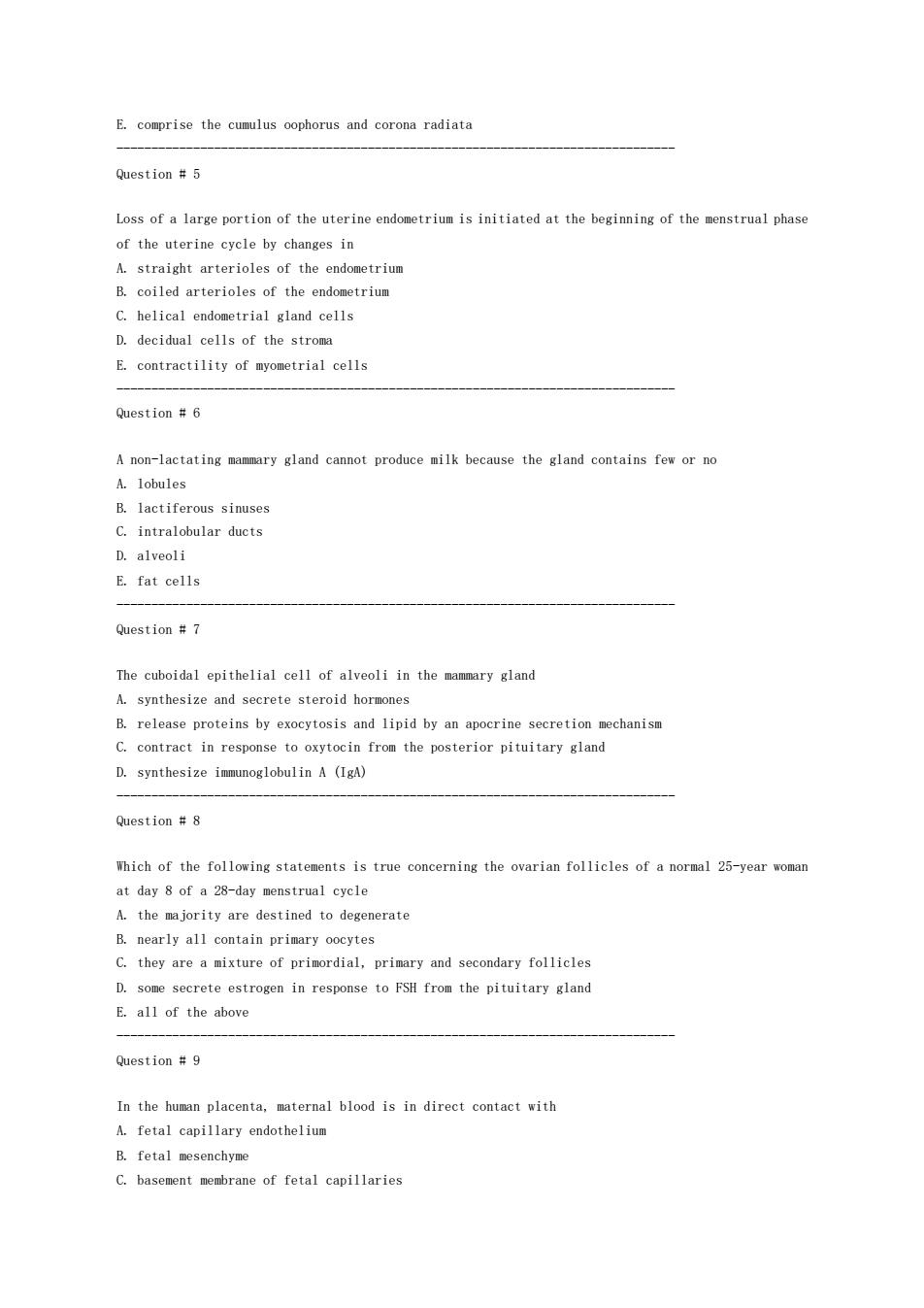
E.comprise the cumulus oophorus and corona radiata Question#5 Loss of a large portion of the uterine endometrium is initiated at the beginning of the menstrual phase of the uterine cycle by changes in A straight arterioles of the endometrium B.coiled arterioles of the endometrium C.helical endometrial gland cells decidual cells of the strom E.contractility of myometrial cells Question 6 A non-lactating mammary gland cannot produce milk because the gland contains few or no B.lactiferous sinuses C.intralobular ducts D.alveoli E fat cells Question#7 The cuboidal epithelial cell of alveoli in the mamary gland A.synthesize and secrete steroid hormones B.release proteins by exocytosis and lipid by an apocrine secretion mechanism C.contract in response to oxytocin from the posterior pituitary gland D.synthesize immunoglobulin A (IgA) Question 8 Which of the following statements is true concerning the ovarian follicles of a normal 25-vear woman at day 8 of a 28-day menstrual cycle A the majority are destined to degenerate arly all c ain primary oocytes C.they are a mixture of primordial,primary and secondary follicles D.some secrete estrogen in response to FSH from the pituitary gland E.all of the above In the human placenta,maternal blood is in direct contact with A fetal capillary endothelium B.fetal mesenchyme C.basement membrane of fetal capillaries
E. comprise the cumulus oophorus and corona radiata -------------------------------------------------------------------------------- Question # 5 Loss of a large portion of the uterine endometrium is initiated at the beginning of the menstrual phase of the uterine cycle by changes in A. straight arterioles of the endometrium B. coiled arterioles of the endometrium C. helical endometrial gland cells D. decidual cells of the stroma E. contractility of myometrial cells -------------------------------------------------------------------------------- Question # 6 A non-lactating mammary gland cannot produce milk because the gland contains few or no A. lobules B. lactiferous sinuses C. intralobular ducts D. alveoli E. fat cells -------------------------------------------------------------------------------- Question # 7 The cuboidal epithelial cell of alveoli in the mammary gland A. synthesize and secrete steroid hormones B. release proteins by exocytosis and lipid by an apocrine secretion mechanism C. contract in response to oxytocin from the posterior pituitary gland D. synthesize immunoglobulin A (IgA) -------------------------------------------------------------------------------- Question # 8 Which of the following statements is true concerning the ovarian follicles of a normal 25-year woman at day 8 of a 28-day menstrual cycle A. the majority are destined to degenerate B. nearly all contain primary oocytes C. they are a mixture of primordial, primary and secondary follicles D. some secrete estrogen in response to FSH from the pituitary gland E. all of the above -------------------------------------------------------------------------------- Question # 9 In the human placenta, maternal blood is in direct contact with A. fetal capillary endothelium B. fetal mesenchyme C. basement membrane of fetal capillaries
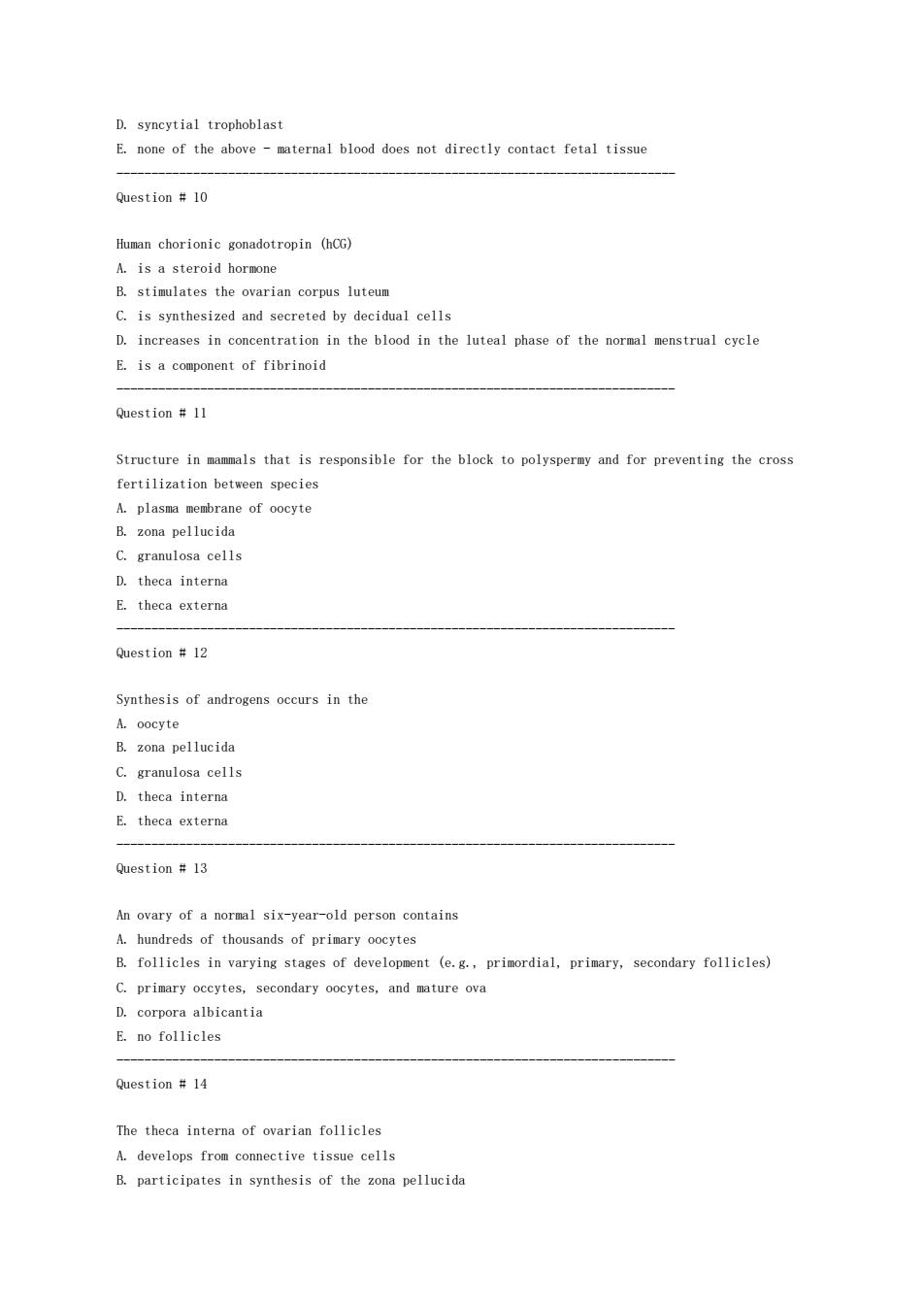
D.syncytial trophoblast E none of the above-maternal blood does not directly contact fetal tissue Question#10 Human chorionic gonadotropin (hCG) A is a steroid hormone B.stimulates the ovarian corpus luteum C.is synthesized and secreted by decidual cells increases in concentration in the blood in the luteal phase of the nornal menstrual cycle E.is a component of fibrinoid Question 11 Structure in amals that is responsible for the block to polyspermy and for preventing the cross fertilization between species A.plasma nembrane of oocyte B.zona pellucida C.granulosa cells D.theca interna E theca externa Question 12 Synthesis of androgens occurs in the A oocyte B.zona pellucida C.granulosa cells D.theca interna E.theca externa Question 13 An ovary of six-yearold person contains A.hundreds s of thousands of primary oocytes B.follicles in varying stages of development (e.g,primordial,primary,secondary follicles) C.primary occytes,secondary oocytes,and mature ova D.corpora albicantia E no follicles Question#14 The theca interna of ovarian follicles A.develops from connective tissue cells B participates in synthesis of the zona pellucida
D. syncytial trophoblast E. none of the above - maternal blood does not directly contact fetal tissue -------------------------------------------------------------------------------- Question # 10 Human chorionic gonadotropin (hCG) A. is a steroid hormone B. stimulates the ovarian corpus luteum C. is synthesized and secreted by decidual cells D. increases in concentration in the blood in the luteal phase of the normal menstrual cycle E. is a component of fibrinoid -------------------------------------------------------------------------------- Question # 11 Structure in mammals that is responsible for the block to polyspermy and for preventing the cross fertilization between species A. plasma membrane of oocyte B. zona pellucida C. granulosa cells D. theca interna E. theca externa -------------------------------------------------------------------------------- Question # 12 Synthesis of androgens occurs in the A. oocyte B. zona pellucida C. granulosa cells D. theca interna E. theca externa -------------------------------------------------------------------------------- Question # 13 An ovary of a normal six-year-old person contains A. hundreds of thousands of primary oocytes B. follicles in varying stages of development (e.g., primordial, primary, secondary follicles) C. primary occytes, secondary oocytes, and mature ova D. corpora albicantia E. no follicles -------------------------------------------------------------------------------- Question # 14 The theca interna of ovarian follicles A. develops from connective tissue cells B. participates in synthesis of the zona pellucida
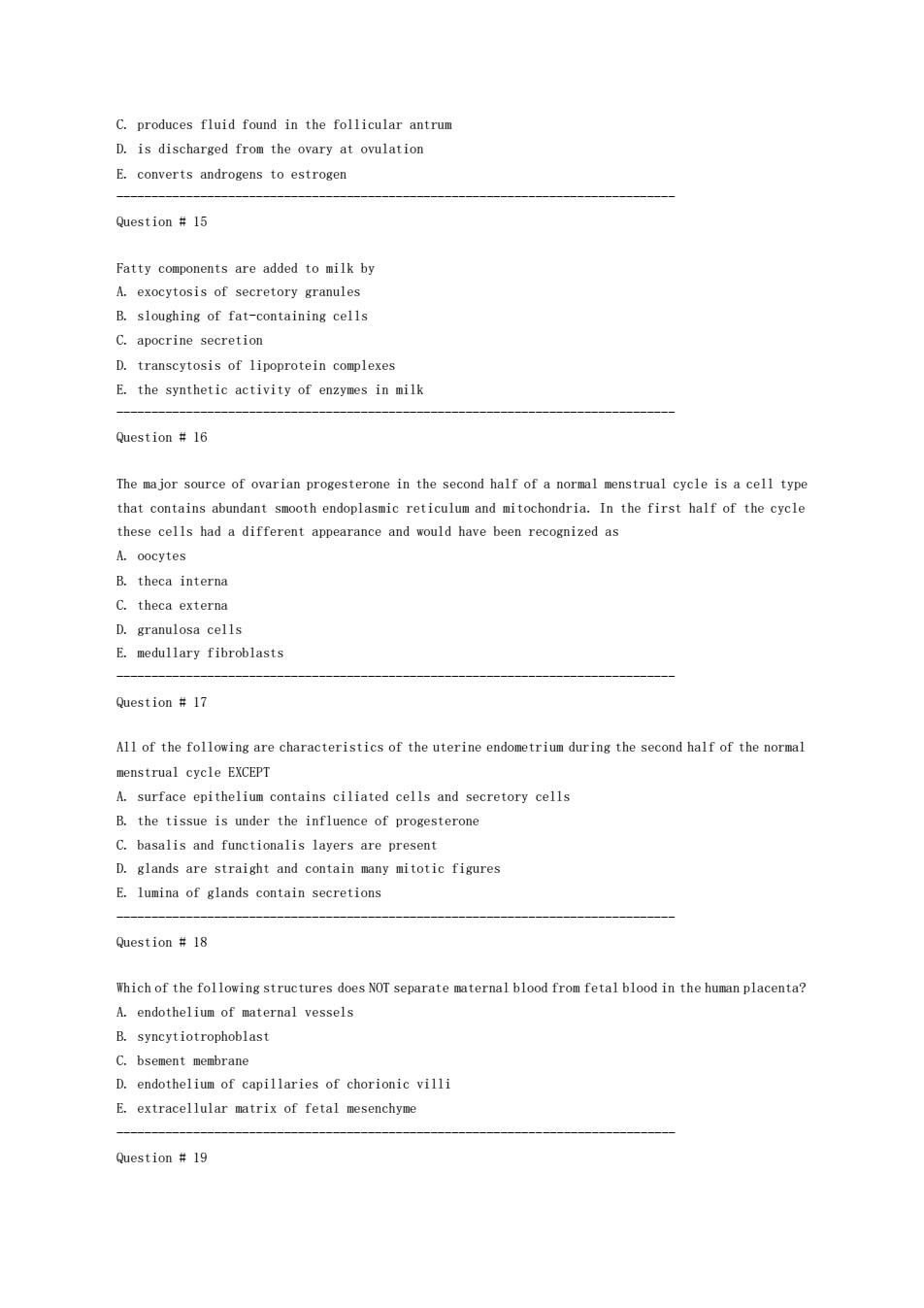
C.produces fluid found in the follicular antrum D.is discharged fron the ovary at ovulation E.converts androgens to estrogen Question 15 Fatty components are added to milk by A exoeytosis of secretory granules B.sloughing of fat-containing cells apocri e secretion D.transcytosis of lipoprotein complexes E the synthetic activity of enzymes in milk Question #16 that contains abundant smooth endoplasmic reticulum and mitochondria.In the first half of the cycle these cells had a different appearance and would have been recognized as A oocytes B.theca interna C.theca externa D.granulosa cells E.medullary fibroblasts Question #17 All of the following are characteristics of the uterine endometrium during the second half of the normal enstrual cycle EXCEPT A.surface epithelium contains ciliated cells and secretory cells B.the tissue is under the influence of progesterone C.basalis and functionalis lavers are present D.glands are straight and contain many mitotic figures E lumina of glands contain secretions Which of the following structures does NOT separate naternal blood from fetal blood in the hunan placenta? A.endothelium of maternal vessels B.syncytiotrophoblast endotheli of capillaries of chorinic villi E.extracellular matrix of fetal mesenchyme Question 19
C. produces fluid found in the follicular antrum D. is discharged from the ovary at ovulation E. converts androgens to estrogen -------------------------------------------------------------------------------- Question # 15 Fatty components are added to milk by A. exocytosis of secretory granules B. sloughing of fat-containing cells C. apocrine secretion D. transcytosis of lipoprotein complexes E. the synthetic activity of enzymes in milk -------------------------------------------------------------------------------- Question # 16 The major source of ovarian progesterone in the second half of a normal menstrual cycle is a cell type that contains abundant smooth endoplasmic reticulum and mitochondria. In the first half of the cycle these cells had a different appearance and would have been recognized as A. oocytes B. theca interna C. theca externa D. granulosa cells E. medullary fibroblasts -------------------------------------------------------------------------------- Question # 17 All of the following are characteristics of the uterine endometrium during the second half of the normal menstrual cycle EXCEPT A. surface epithelium contains ciliated cells and secretory cells B. the tissue is under the influence of progesterone C. basalis and functionalis layers are present D. glands are straight and contain many mitotic figures E. lumina of glands contain secretions -------------------------------------------------------------------------------- Question # 18 Which of the following structures does NOT separate maternal blood from fetal blood in the human placenta? A. endothelium of maternal vessels B. syncytiotrophoblast C. bsement membrane D. endothelium of capillaries of chorionic villi E. extracellular matrix of fetal mesenchyme -------------------------------------------------------------------------------- Question # 19
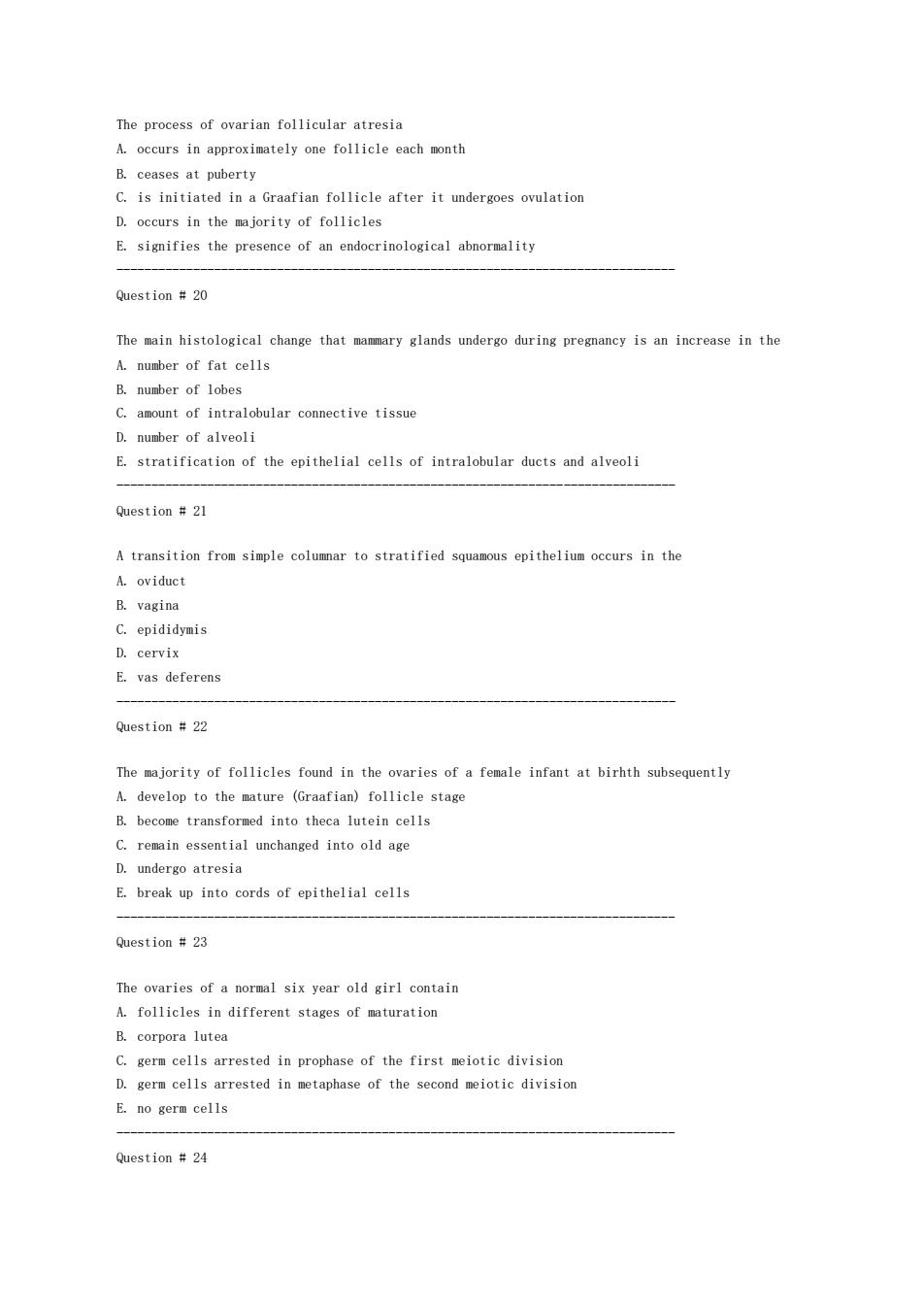
The process of ovarian follicular atresia ceases at puberty C.is initiated in a Graafian follicle after it undergoes ovulation D.occurs in the majority of follicles E signifies the presence of an endocrinological abnormality Question#20 The min histological change that amary glands undergo during pregnancy is an increase in the A.number of fat cells B.number of lobes C.anount of intralobular connective tissue D.number of alveoli Estratification of the epithelial cells of intralobular ducts and alveoli Question 21 A transition from simple columar to stratified squamous epithelium occurs in the A oviduct vagin C.epididymis D.cervix E vas deferens Question#22 The mjority of follicles found in the ovaries ofa femle infant at birhth subsequently A develop to the mature (Graafian)follicle stage B.become transformed into theca lutein cells C.remain essential unchanged into old age D.undergo atresia E break up into cords of epithelial cells Question 23 The ovaries of a normal six year old girl contain A follicles in different stages of maturation B.corpora lutea in prophase of the first eiotic divisio D.germ cells arrested in metaphase of the second meiotic divisio E.no germ cells Question#24
The process of ovarian follicular atresia A. occurs in approximately one follicle each month B. ceases at puberty C. is initiated in a Graafian follicle after it undergoes ovulation D. occurs in the majority of follicles E. signifies the presence of an endocrinological abnormality -------------------------------------------------------------------------------- Question # 20 The main histological change that mammary glands undergo during pregnancy is an increase in the A. number of fat cells B. number of lobes C. amount of intralobular connective tissue D. number of alveoli E. stratification of the epithelial cells of intralobular ducts and alveoli -------------------------------------------------------------------------------- Question # 21 A transition from simple columnar to stratified squamous epithelium occurs in the A. oviduct B. vagina C. epididymis D. cervix E. vas deferens -------------------------------------------------------------------------------- Question # 22 The majority of follicles found in the ovaries of a female infant at birhth subsequently A. develop to the mature (Graafian) follicle stage B. become transformed into theca lutein cells C. remain essential unchanged into old age D. undergo atresia E. break up into cords of epithelial cells -------------------------------------------------------------------------------- Question # 23 The ovaries of a normal six year old girl contain A. follicles in different stages of maturation B. corpora lutea C. germ cells arrested in prophase of the first meiotic division D. germ cells arrested in metaphase of the second meiotic division E. no germ cells -------------------------------------------------------------------------------- Question # 24